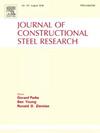电弧增材制造强化工字型钢梁的残余应力
IF 4
2区 工程技术
Q1 CONSTRUCTION & BUILDING TECHNOLOGY
引用次数: 0
摘要
本文对三根waam加固工字钢截面梁的残余应力和残余变形进行了实验测量和数值模拟。采用广泛使用的切片法测量残余应力,结果表明,在加入WAAM材料后,热轧型钢i型截面的原始潜在残余应力分布发生了显著变化,这主要是由于制造过程中的热量输入。在不同的WAAM材料布置下,观察到不同的残余应力模式。采用三维激光扫描测量了构件水平的整体弯曲变形(即预弯)和截面水平的局部弯曲变形。然后,采用集总层序热-力学有限元(FE)建模方法对试件内的残余应力和变形进行了数值模拟。计算结果与实验结果吻合较好。实测的残余应力和验证的数值方法可用于waam加固工字钢梁的设计和相应设计规范的制定。本文章由计算机程序翻译,如有差异,请以英文原文为准。
Residual stresses in steel I-section beams strengthened by wire arc additive manufacturing
The residual stress and residual distortion of three WAAM-strengthened steel I-section beams have been measured experimentally and simulated numerically in the present study. The widely used sectioning method was employed for the measurement of residual stresses, with the results revealing that the original underlying residual stress distribution in the studied hot-rolled steel I-section was significantly altered after the addition of the WAAM material, primarily owing to the heat input from the manufacturing process. Different residual stress patterns were observed for specimens with varying WAAM material arrangements. The overall bending distortion at the member level, also referred to as the pre-camber, and the local distortion at the cross-sectional level, were measured by means of 3D laser scanning. A lumped-layer sequential thermal–mechanical finite element (FE) modelling approach was then used to simulate the residual stresses and distortion within the examined specimens numerically. Good agreement was found between the FE results and the experimental observations. The measured residual stresses and the validated numerical approach can be employed in the design of WAAM-strengthened steel I-section beams and in the development of corresponding design provisions.
求助全文
通过发布文献求助,成功后即可免费获取论文全文。
去求助
来源期刊

Journal of Constructional Steel Research
工程技术-工程:土木
CiteScore
7.90
自引率
19.50%
发文量
550
审稿时长
46 days
期刊介绍:
The Journal of Constructional Steel Research provides an international forum for the presentation and discussion of the latest developments in structural steel research and their applications. It is aimed not only at researchers but also at those likely to be most affected by research results, i.e. designers and fabricators. Original papers of a high standard dealing with all aspects of steel research including theoretical and experimental research on elements, assemblages, connection and material properties are considered for publication.
 求助内容:
求助内容: 应助结果提醒方式:
应助结果提醒方式:


